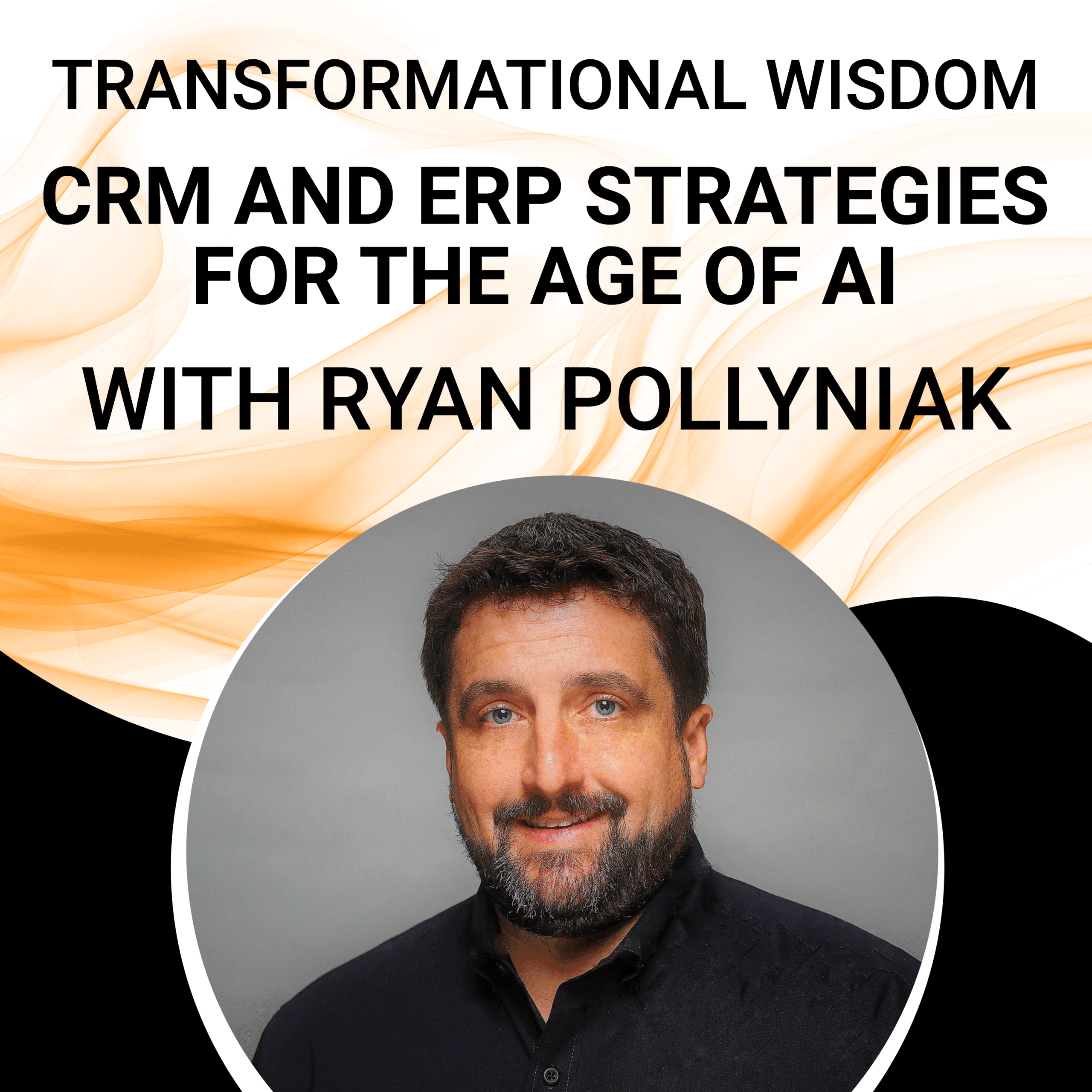Beyond the dazzling headlines of Generative AI, a familiar hurdle from past tech rollouts like CRM remains: genuine user adoption. If your organization sees GenAI primarily as a technology challenge, you might be missing the crucial human equation. Join us on Innovation Tales as host Alexandre Nevski and guest Ryan Pollyniak, a seasoned sales professional, share frontline stories and hard-won lessons on navigating the people-side of digital transformation, ensuring your initiatives inspire action, not resistance.
Key Takeaways
- Prioritize People in Every Tech Initiative: Successful Digital Transformation, whether with CRM or AI, depends more on genuine user adoption and addressing the human impact than on the technology itself; understanding personal motivations and ensuring a clear “What’s In It For Me?” (WIIFM) for employees is paramount.
- Executive Sponsorship and True Partnership are Non-Negotiable: Visible Leadership, unwavering executive buy-in, and a collaborative approach with implementation partners are essential to overcome resistance, manage change effectively, and prevent costly deviations from strategic goals.
- Approach AI Strategically, Starting with Data Readiness: While AI and Machine Learning offer transformative potential, organizations must first ensure their data is clean and aggregated, then strategically integrate AI to solve specific business problems rather than adopting technology for its own sake, focusing on both tactical efficiencies and long-term strategic insights.
The Enduring Challenge: Why CRM Transformations Mirror Today’s AI Adoption Hurdles
The promise of groundbreaking technologies like Generative AI can be incredibly exciting for any organization focused on Digital Transformation. However, as history with Customer Relationship Management (CRM) systems has shown, the most significant barrier to success often isn’t the technology itself, but rather the human element. It’s estimated that a staggering percentage of CRM deployments, up to 70% in some cases, falter due to poor user adoption. This isn’t about faulty software; it’s about a disconnect between strategic goals, established processes, and the personal motivations of the individuals expected to use the new tools. Smart algorithms and advanced AI capabilities are rendered ineffective if users don’t embrace them and integrate them into their daily work. This episode of Innovation Tales dives deep into this critical aspect, drawing parallels between past CRM rollouts that exceeded budgets and failed to deliver, and the current challenges businesses face with adopting AI and Machine Learning. The focus, as emphasized by guest Ryan Pollyniak, a veteran in the Microsoft Dynamics space, must be on the people to truly unlock the value of any technological advancement, particularly in risk-averse environments where change can be met with skepticism.

Navigating the Treacherous Waters of CRM Transformation: A Case Study
Embarking on a major technology overhaul, such as replacing a long-standing Enterprise Resource Planning (ERP) or CRM system, is a journey fraught with complexities that extend far beyond mere technical configuration. Ryan shared a compelling example of an organization transitioning from a deeply entrenched ERP system that had been customized and woven into the fabric of their operations for over a decade. When a system becomes so integral, and an organization scales around it, processes and technology become inextricably linked. More than that, employees often develop a strong sense of ownership and familiarity with their established ways of working. This personal attachment can be a formidable hurdle in any Digital Transformation effort.
The Human Element: When Technology Change Gets Personal
They’ve poured their effort and blood, sweat, and tears into this application for such a long time. And now you’re gonna take it away from them. There’s a very personal element to that.
The moment a company decides to replace such a system, the project immediately enters the realm of intensive change management. It’s not just about installing new software; it’s about guiding people through a period of significant adjustment. Employees need to understand the rationale behind the change, how it will directly impact their roles and responsibilities, and why the organization is undertaking this considerable move. In the case Ryan described, the challenge was amplified by an internal “owner” of the existing CRM – someone who had invested considerable time and energy, their “blood, sweat, and tears,” into the application. The prospect of taking away “their baby” introduces a deeply personal and emotional dimension to the Digital Transformation, underscoring the need for a Human-Centered AI approach, even when dealing with foundational systems like CRM. This initial resistance is a critical factor that Leadership must anticipate and manage with empathy and clear communication to foster Employee Engagement.
The Linchpin of Success: Securing Executive Buy-In for Digital Transformation
For any large-scale technology project, especially one replacing an enterprise CRM, securing unwavering executive buy-in from the outset is not just beneficial—it’s indispensable. Ryan emphasized that early in the process, the implementation team had to align closely with the company’s executives, making it clear that their active participation was crucial for success. The message was stark: attempting to replace a deeply embedded system without top-level commitment to manage the ensuing change would be a recipe for failure. Pushback, pain points, and a natural inclination to replicate the old system within the new one are inevitable challenges. This tendency to rebuild the past is a significant pitfall in technology projects, and CRM implementations are certainly no exception. If there are valid reasons for adopting a new application, the goal should be to leverage its intended capabilities, not to force it into the mold of the old system.
The core of managing this change effectively lies in articulating the “why.” Just as children invariably ask “why?” when told to do something, employees, too, need to understand the reasons behind a major shift like a CRM change. Is the business evolving? Is the current technology outdated, causing the company to lag behind competitors? Have acquisitions brought in new business units with different requirements? Clearly communicating this “why” is the foundational step in the change management process. It frames the organizational necessity for the Digital Transformation. However, this is only part of the equation. The next, equally critical step is addressing how the change will impact each individual personally – a key aspect of successful Leadership in driving technological adoption and fostering Trust.
In Ryan’s experience, even with executive agreement on budget and timeline control, the only way to achieve these goals was to ensure the new CRM (Microsoft Dynamics, in this instance) was used as intended. Customizing it extensively to mirror old processes would inevitably lead to budget overruns and extended timelines, transforming the project into a custom development effort. This is particularly pertinent in the current Software-as-a-Service (SaaS) landscape, where cloud-based applications receive automatic updates multiple times a year. Heavy customization can make these updates painful and costly to manage. Fortunately, in the highlighted project, the CEO, CFO, and COO understood this and provided the necessary support, paving the way for a more strategic implementation of AI and Automation features inherent in modern CRM platforms.
Breaking Through Resistance: A Partnership Approach to Change
Any executives listening out there who are going to do a technology project, you can’t put the entire onus on your implementation partner. It has to be a joint effort, a partnership.
Despite initial executive alignment, resistance from within the organization began to surface as consultants engaged with the project. This pushback often manifested as a desire to recreate the old system’s functionalities—a common and understandable reaction. Navigating this requires persistent communication and a strong partnership between the client and the implementation partner. Ryan stressed that executives undertaking technology projects cannot simply delegate the entire responsibility to their vendor; it must be a collaborative effort. Continuous dialogue with the executive team, reiterating the need for their support in managing internal resistance, was key. Eventually, this support materialized, sometimes involving difficult decisions like reassigning key personnel who, despite their value to the organization, were too focused on past methods to effectively lead the functional aspects of the new implementation. This allowed for a fresh perspective, ultimately leading to a successful go-live, under budget, and with a final product that met the company’s strategic needs. This underscores the importance of true partnership and robust, executive-led change management in achieving successful Digital Transformation.
Essential Tools and Mindsets for Facilitating Change and Adoption
Successfully guiding teams through technological transitions requires more than just a project plan; it demands a well-equipped toolkit for change management and fostering adoption. This involves understanding the distinct roles of different partners and internal processes, ensuring that the chosen technology truly aligns with strategic objectives for Digital Transformation.
The Partner’s Role: Beyond Implementation to Best Practices
Technology partners play a vital role as experts who have navigated similar implementations numerous times. Their responsibility extends to providing context through best practices, demonstrating how other organizations in similar situations leverage the application, and clarifying how the software is intended to be used. This guidance is crucial for helping businesses avoid common pitfalls and maximize the value of their investment. It’s about steering clients towards efficient use of standard features, which can often support Automation of routine tasks and lay the groundwork for future AI integrations, rather than immediately resorting to costly customizations.
Business Process Re-engineering vs. Technology Implementation
If you wanna take a look at that without a solution in context, you really need a business process re-engineering firm or consultant who can take a system agnostic view of that and say, here are the holes in your business that you need to plug.
Ryan highlighted a critical distinction between implementing a technology solution and engaging in comprehensive Business Process Re-engineering. There’s a fine line: if an organization needs to fundamentally reassess its operational methods due to business changes or inefficiencies, it’s often best to undertake this review *before* selecting a specific technology. This might involve a BPR consultant who can take a system-agnostic view, identify operational gaps, and help define the desired future state. Once these optimal processes are mapped out, the organization is better positioned to find a technology partner and a solution that can effectively support these refined workflows. Some firms offer both BPR and technology implementation, but Ryan suggested a preference for separating these to some degree, ensuring an unbiased view of process needs before diving into software selection. This strategic approach is vital, especially when considering how Machine Learning capabilities might be leveraged down the line, as well-defined processes provide clearer data for AI systems to analyze.
The Courage to Say “No”: Ensuring a True Fit and Building Trust
A hallmark of a reliable technology partner is their willingness to be transparent, even if it means advising against their own solution. A good partner won’t simply agree to every request or “check all the boxes” without a deep understanding of the client’s needs and the solution’s actual fit. Ryan recounted an early career experience where an executive, new to the discussions and pressed for time, demanded a five-minute pitch on why their company should choose Ryan’s firm. His honest response—that he didn’t yet know if they *should* and that the purpose of the engagement was to figure that out together—set a tone of transparency. This approach is fundamental. The last thing a reputable partner wants is to engage in a project where they cannot deliver success. Starting a relationship with non-transparent, sales-driven answers erodes Trust and sets a poor precedent for the inevitable tough conversations that arise during complex initiatives. For effective Human-AI Collaboration and digital maturity, this foundation of trust and honesty is paramount.
The Dawn of AI in Customer-Facing Functions: Opportunities and Considerations
The conversation naturally shifted towards the burgeoning impact of Artificial Intelligence, particularly within customer-centric departments like customer service and sales. The landscape of AI is dynamic, with capabilities evolving daily, making it both an exciting and challenging domain for businesses pursuing Digital Transformation.
AI’s Evolving Role: From Horizon to Reality
While the ultimate potential of AI is still unfolding, its presence is increasingly tangible. Major SaaS CRM players, including Microsoft Dynamics with its various “Co-pilot” offerings for sales and customer service, are heavily integrating AI features into their platforms. Release notes are now frequently dominated by AI-driven enhancements, signaling a clear direction for the industry. This rapid evolution means that the true value of these tools is an ongoing discovery process for both vendors and users.
Practical AI Use Cases: Enhancing Customer Service
AI may not be coming for your job as a customer service rep, but somebody using AI efficiently maybe coming for your job because they’re gonna be better at what they do.
Concrete applications of AI are already emerging and delivering value. In customer service, for instance, when a support case is logged through a portal, AI can automatically suggest potential solutions without any human intervention. It can also significantly boost the efficiency of human agents by providing them with relevant solutions quickly, reducing the need to manually search through knowledge bases or documentation. This not only speeds up resolution times but also enhances the customer experience. However, this introduction of Automation and AI can also stir apprehension among employees about job security. Ryan emphasized that the current answer to “Am I going to be replaced?” is typically “humans are still absolutely required.” The focus is on Human-AI Collaboration, where AI augments human capabilities, freeing up employees for more complex or empathetic tasks. This fosters better Employee Engagement when communicated effectively. A key insight Ryan offered is that while AI itself might not be coming for your job, an individual who efficiently uses AI might be, as they will likely be more productive and effective.
The Shift in Partner Selection: Prioritizing Technology Foundation and AI Readiness
A significant consequence of AI‘s rise is the shift in how organizations should select technology partners and solutions. The decision is becoming less about a checklist of current features and more about the underlying technology foundation of the potential partner. A smaller, niche vendor might perfectly cater to a specific industry’s current needs but may lack the resources or robust technological base (including support for Low-Code development) to effectively integrate and leverage upcoming AI advancements. Therefore, understanding a vendor’s AI roadmap and their platform’s capacity for future growth is more critical than ever for long-term Digital Transformation success.
Empowering Sales with AI: Smarter Engagement and the “WIIFM” Factor
That’s the old WIIFM, if you ever heard of it. It’s one of my favorite radio stations, right? What’s in it for me?
In the sales domain, AI offers powerful tools for enhancing effectiveness. Out-of-the-box features can, for example, alert a salesperson that a prospect has shown interest (perhaps analyzed from email content) and hasn’t been contacted recently, even suggesting sending an email. This kind of proactive assistance, surfaced directly in the user interface, can significantly improve engagement. This ties directly back to change management and the crucial “What’s In It For Me?” (WIIFM) question. For a salesperson accustomed to managing leads in a notebook or spreadsheet for years, the adoption of a new CRM infused with AI needs a compelling personal value proposition. When Leadership can clearly explain that the AI will help prioritize leads, close more sales, and ultimately increase their earnings, the motivation for adoption becomes intrinsic. This human-centered approach is vital for ensuring that new technologies like Human-Centered AI actually get used.
Beyond Productivity: AI as a Quality Assurance Partner
Beyond direct productivity boosts, AI is also emerging as a valuable partner in ensuring quality and adherence to processes. Humans can struggle with maintaining constant focus on repetitive tasks. AI can act as an over-the-shoulder assistant, quickly reviewing work (like a completed customer service case) against standard operating procedures to ensure all necessary steps have been taken, without requiring managerial oversight for every minor detail. This provides reassurance to employees and improves overall consistency. Furthermore, AI serves as a powerful research assistant, capable of sifting through vast knowledge bases to provide quick answers, saving valuable time and effort.
Understanding AI’s Dual Impact: Tactical Efficiencies vs. Strategic Transformation

To truly harness the power of Artificial Intelligence, it’s crucial for organizations, especially those in risk-averse environments, to distinguish between its different applications. Ryan proposed a helpful categorization: tactical AI and strategic AI. Both play a role in Digital Transformation, but they address different needs and require different levels of organizational readiness.
Tactical AI: Boosting Individual Productivity
Tactical AI refers to the tools and features that enhance individual efficiency in day-to-day tasks. This includes using AI to revise an email, generate text for a paragraph using tools like ChatGPT, populate a spreadsheet, or even create a PowerPoint presentation. These applications offer immediate, tangible benefits in terms of time-saving and productivity. Ryan stressed that employees who are unwilling to embrace these tactical AI tools risk falling behind their colleagues and competitors in performance. Adopting these efficiencies is becoming a baseline expectation for modern professionals and a key component of successful Human-AI Collaboration.
Strategic AI: Driving Enterprise-Level Decisions with Machine Learning
Strategic AI, on the other hand, involves leveraging Machine Learning and broader AI capabilities to analyze organizational data, derive business insights, and drive high-level decision-making. This is a far more complex endeavor than individual productivity enhancements. Ryan shared an amusing but relatable cartoon: a boss telling an employee, “We need AI, make it happen!” When asked what they want to use it for, the boss replies, “I don’t know, but we need it immediately!” This often reflects reality. Many organizations feel the pressure to adopt AI without a clear strategy. However, to effectively use AI for strategic business analytics and enterprise-level decisions, a critical prerequisite is often overlooked: clean, well-organized, and aggregated data, preferably in the cloud. If an organization’s data is siloed in Excel sheets, Outlook inboxes, physical notebooks, or antiquated on-premise ERP systems, it simply isn’t ready to leverage strategic AI. While tactical AI can be used almost immediately, the journey to strategic AI requires significant groundwork in data management and governance, which is a core part of effective Business Process Management (BPM) and Leadership in the digital age.
Personal Effectiveness in the Age of Distraction: Lessons from “Essentialism”
Prioritize your own day. Don’t let your Outlook inbox do that for you.
Beyond organizational strategies for Digital Transformation and AI adoption, personal effectiveness remains a cornerstone of success for leaders and their teams. When asked about a book, tool, or habit that has made a significant impact, Ryan pointed to the principles outlined in “Essentialism” by Greg McKeown and their practical application in managing the daily deluge of information and demands. His key advice centers on proactively prioritizing your day rather than letting your email inbox dictate your agenda. Most professionals have a handful of high-value tasks that will genuinely impact their performance and help them achieve their objectives. The discipline lies in consciously choosing to tackle these first, resisting the urge to start with the often less critical items that appear at the top of an inbox. A crucial tactic Ryan employs is turning off email notifications. These pop-ups, by their very nature, grab attention and can easily derail focus, pulling individuals into less valuable tasks and down unproductive rabbit holes. By keeping Outlook or other email applications closed during focused work periods and batch-processing emails later, individuals can reclaim control over their time and ensure their energy is directed towards what truly matters. This disciplined approach to managing attention is vital for effective Leadership and maintaining productivity amidst constant digital noise.
The Unchanging Core in a World of Change: The Primacy of Human Connection
The main problem with communication is the illusion that it’s already happened.
In a world characterized by relentless technological advancement and constant change, it’s insightful to consider what might remain constant. When posed this question, Ryan unequivocally pointed to the human element. The critical importance of communication, empathy, and the ability to put oneself in another person’s shoes will not diminish, even a decade from now. He shared a favorite saying: “The main problem with communication is the illusion that it’s already happened.” This highlights a common pitfall, especially in technology projects, where experts might assume their audience possesses the same level of understanding, or vice versa. In any Digital Transformation, and particularly with the roll-out of AI and Machine Learning tools, bridging this knowledge gap is essential. Assumptions can lead to misunderstandings and resistance.
Leaders cannot simply dictate change with a “my way or the highway” approach. Effective Leadership requires going deeper: clearly articulating the “why” behind the change, explaining how it will specifically affect individuals (addressing the “What’s In It For Me?” factor), actively listening to their concerns, and providing the necessary support and empowerment for them to use new tools successfully. This involves continuous care, fostering an environment where employees can grow and thrive with new technologies. This profound focus on Human-Centered AI principles, on understanding motivations, and on genuine two-way communication is the bedrock of successful change and will remain an enduring truth, regardless of how sophisticated our technology becomes. Building and maintaining Trust through open dialogue and genuine concern for Employee Engagement are timeless pillars of success.
Conclusion: The Human Core of Technological Triumph
Ultimately, as Ryan Pollyniak illuminated, successful Digital Transformation—whether navigating complex CRM migrations or embracing the potential of AI—is profoundly human. It’s about clear communication, empathetic Leadership that addresses the ‘why’ and the ‘what’s in it for me,’ and fostering genuine partnerships. By focusing on these core principles alongside strategic technology choices and robust data foundations, organizations can ensure their innovations inspire action, build Trust, and deliver lasting value, turning ambitious tech visions into tangible realities grounded in Human-Centered AI approaches.
Continue Your Journey
Inspired by Ryan’s insights on navigating the people-side of tech adoption and fostering self-sufficiency through smart Automation and AI? To see how these human-centered approaches are put into practice, and to learn more about building confidence in your technology, processes, and decisions, you can explore the resources and work of Ryan and his team at Western Computer, often highlighted in our episode description.
Join the Conversation
Leading transformative change often involves navigating deeply human challenges. What’s one strategy your team has found effective in fostering Employee Engagement and Trust during a significant technology or process shift, perhaps involving AI or new CRM systems? Share your experiences and insights with the Innovation Tales community on our LinkedIn page.
Resources
- “Essentialism: The Disciplined Pursuit of Less” by Greg McKeown 📖 Explore on Goodreads

Episode timeline
- 00:00 Introduction and Agenda
- 00:00 CRM Transformation Challenges
- 00:00 Change Management Essentials
- 00:00 Executive Buy-In and Project Success
- 00:00 Overcoming Resistance to Change
- 00:00 Tools for Facilitating Change
- 00:00 AI in Customer Service and Sales
- 00:00 Tactical vs. Strategic AI
- 00:00 Personal Productivity Tips
- 00:00 The Importance of Communication
- 00:00 Conclusion and Final Thoughts





